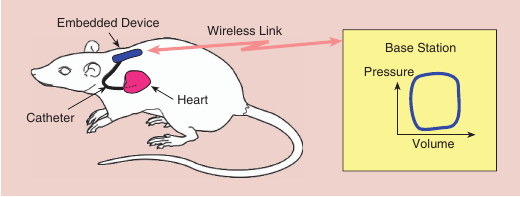
Embedded medical devices: Pressure volume loops in rodents
Embedded medical devices: Pressure volume loops in rodents
By Kathryn Loeffler, John E. Porterfield, Erik R. Larson, Daniel Escobedo, G. Patricia Escobar, John A. Pearce, Marc D. Feldman, and Jonathan W. Valvano
NOTE: This is an overview of the entire article, which appeared in the January/February 2013 issue of the IEEE Potentials magazine.
Click here to read the entire article.
This article discusses a device implantable in rats that measures heart volume and blood pressure, as illustrated in the figure below. The pressure-volume catheter is inserted into the left ventricle of the rat’s heart. The device measures left ventricular pressure and volume and transmits the data to a base station via a wireless link. The base station records and plots pressure-volume loops.

Block diagram illustrating the components of the embedded device capable of measuring pressure and volume.
Why the interest in measuring cardiac pressure and volume in a mouse or rat, using implanted devices? Because new drugs are commonly tested using transgenic models of heart disease. As a result, it has become important to accurately and thoroughly evaluate cardiac function in rodents (mice and rats). Rodent hearts are extremely sensitive to sedation and yield very different results when conscious studies are compared to those using anesthesia. Therefore, it is of paramount importance that a complete assessment of cardiac function is carried out in freely roaming, unanaesthetized rodents. In order to accomplish this goal, wireless devices that utilize miniature, lightweight implants to transmit data to a nearby base station must be used.
There are many embedded devices available for use in larger animals but very few for rats and mice. The authors discuss challenges they faced in producing a prototype for implantation in rats. These include biocompatibility, electrical safety, and low power operation.
A catheter with four ring impedance electrodes and a pressure sensor is inserted in the left ventricle of the animal. The volume of blood in the ventricle is determined based on the impedance as measured by the catheter electrodes.
Because the circuitry is powered by an implanted battery, power usage must be minimized. The device is only powered up for 6 seconds when cardiac measurements are being made.
Read the article for more information on the prototype, with illustrations of sample measurements and the authors’ plans for future devices – extending to implantation in mice.
ABOUT THE AUTHORS
NOTE: More complete biographical information on the authors is provided in the article.
Kathryn Loeffler (katy.loeffler@gmail.com) received her B.S. degree in biomedical engineering from the University of Texas at Austin in 2010. She is currently a graduate student in electrical and computer engineering at the University of Texas at Austin.
John E. Porterfield (johnporterfield@admittancetechnologies.com) received his Ph.D. from the University of Texas at Austin. He is currently chief scientific officer for Admittance Technologies Inc.
Erik R. Larson (larson@ece.utexas.edu) received his Ph.D. from the University of Texas at Austin. He is currently a research engineer at Windmill Cardiovascular Systems, Austin, Texas.
Daniel Escobedo (escobedod@uthscsa.edu) is a research associate in the Department of Medicine/Cardiology at the University of Texas Health Science Center in San Antonio.
G. Patricia Escobar (escobarg@uthscsa.edu) received her D.V.M degree from Bogota, Colombia, She is at the Janey Briscoe Center for Cardiovascular Research.
John A. Pearce (jpearce@mail.utexas.edu) received his Ph.D. degree in electrical engineering from Purdue University. He is presently the Temple Foundation Professor in electrical engineering at the University of Texas at Austin. He is a Senior Member of the IEEE.
Marc D. Feldman (Feldmanm@uthscsa.edu) received his M.D. degree from the University of Pennsylvania School of Medicine, Philadelphia. He is currently professor of medicine and engineering, director of the Cardiac Catheterization Laboratories, Division of Cardiology at The University of Texas Health Science Center at San Antonio. He is also an adjunct professor at The University of Texas at Austin.
Jonathan W. Valvano (valvano@mail.utexas.edu) received his Ph.D. degree in medical engineering from the Harvard University/MIT Division of Health Sciences and Technology. He is currently a full professor at The University of Texas at Austin He is a Member of the IEEE.






